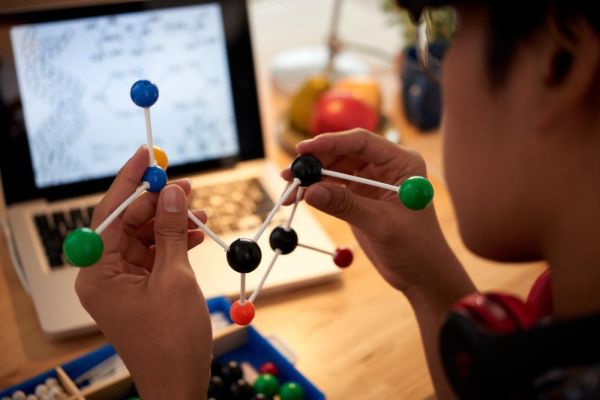Unlocking the Power of Gamification in Education
Schools previously shied from implementing gamification because they feared rejection and lack of adoption. Educators who tried it initially realized its potential and invested more in it. Many educational institutions use this technology today causing unexpected shifts.
Data shows that 80% of students using gamification prove more effective. Schools use generative AI to create educational games and achieve learning goals. Students enjoy using this technology because it is immersive and engaging.

https://www.freepik.com/free-photo/examining-molecular-model_5766349.htm
What is gamification in education?
Gamification definition by education experts is the power to improve engagement and motivation through games. These games integrate elements loved by learners into lessons. Students appreciate rewards and activities that challenge them to stretch further. Gamification in education uses similar elements to change school lessons into dynamic engaging experiences.
Writing essays might feel burdensome to some students but letting a professional service carry the burden changes the experience. A reputed online writing service providing online help to learners seeking to change the status of their current grades is important. There are benefits of using EduBirdie top writers because their professionalism surpasses most writers elsewhere. They meet every student’s deadline and keep them engaged. These professionals can take hundreds of orders daily and effectively deliver them without quality compromises. No wonder they have offered services to thousands of students for the last decade.
Benefits of gamification in education in changing learning experiences
Understanding what is gamification in education helps you understand the benefits it has brought to schools. This term was unheard of before the digitization era started allowing the development of online learning platforms. Games are not a new thing to learners because they have played and known them since childhood.
They understand the rules of the games and walk the tight lines ensuring they follow each rule. Innovators were creative and thought introducing these games into the learning environment might work effectively. They created the games with similar elements but also integrated educational elements into them. Each gamification in education element has varying benefits.
-
Challenges: Lets learners determine to explore education further and discover important hidden things. They are brain-teasing elements that help students to think outside of the box and appreciate education.
-
Rewards: Create excitement and anticipation to receive something after completing a game cause/challenge. This expectation causes learners to feel motivated and continue searching for answers.
-
Interactive scenarios: Interactive games like Heavy Rain and Firewatch respond based on learner actions. They are useful to educators, allowing them to gather feedback concerning student learning styles.
-
Leaderboards: These games take competitive learning to the next level creating an opportunity for collaboration and brainstorming. Students come on board to compete and can view their rankings based on scores.

Psychology of gamification in education
The success of gamification in education is pegged to the feeling of excitement and reward expectation from winnings. Gaming excitement stirs the external power of a learner giving them the energy to stay on and learn or discover more. Reward expectation creates a thriving environment of learners focused on one goal.
Accomplishing a goal or a challenging gaming experience might not excite other learners. The student undertaking the challenges is the only one who understands the pain of achieving it. Luckily, they discover the tricks of overcoming it and winning more in the future. This stirs the spirit within them causing them to try out more challenges.
Receiving rewards excites everyone stirring them up to try out the challenge and be rewarded too. Excitement affects everyone who sees the reward recipient happy. Combined, both internal (intrinsic) and external (extrinsic) motivations lead to collaboration. Students love the subjects and discover solutions to complex concepts which improves memory and learning outcomes.
Data shows gamification in education has achieved a huge success making training and student motivation easier. Educational apps in modern learning environments contain gamified elements that change how students view learning. These elements help them search things out, brainstorm, or discover easier learning methods.
For instance, they can use games to brainstorm and search for the easiest way to find a 750 word essay example online. There are more than a dozen gamified apps that most schools have adopted and appreciate the results.
-
Quizzes. Quiz apps contain games that let students answer questions in a digital game. They receive rewards from quiz apps like Codecademy and Forest and experience interactive gaming at a higher level.
-
Adventure. Games like Molton Brown and Pokemon lead students into exploration experiences finding solutions to concepts. They let them experiment with things and discover the outcomes of mixing things up.
-
Competitions. Games like Kahoot and 10 Questions allow students to compete in an intensive game platform. They compete to find answers to questions or create questions for others to answer.
Challenges of gamified learning in schools
Students might be easily immersed in gaming and forget the other aspects of learning progress. Teachers should provide guidance in helping learners balance between gamified education and traditional studies. Developers may emphasize more on the rewards side and ignore the learning side which creates biases in the game. Some games could be manipulative to learners raising questions about ethics and online security.
Ways to include gamified lessons in the classroom
Educators should not rush to buy an educational game before searching things out to determine whether it fits their team of learners. Determine the goals the game must achieve and create an implementation plan. Students understand the games and it might be a good idea to involve them.
Upgrade your classroom lessons table to include games for specific lessons. Decide which lessons will work better with games and present the budget to the administration team for funding. Ensure there is a perfect balance between games and other forms of learning.
Conclusion
Gamification in education is taking a different dimension in schools helping students love learning and explore things. The best outcome game forms an understanding of what is gamification and the approaches that work. Educators should create an implementation plan by first identifying the goals, relevant apps, and budget. This approach is engaging but a balance helps students not to go overboard focusing more on the games and ignoring the other side of learning.
Author’s Bio
Cris Bell loves gaming, tech, AI, coding and many other topics in the technology domain. His writing is so engaging and worth sharing that the audiences can’t stop themselves from pressing the like or share button. He’s equally good in essay writing where he handles technology and also math and science for college students.